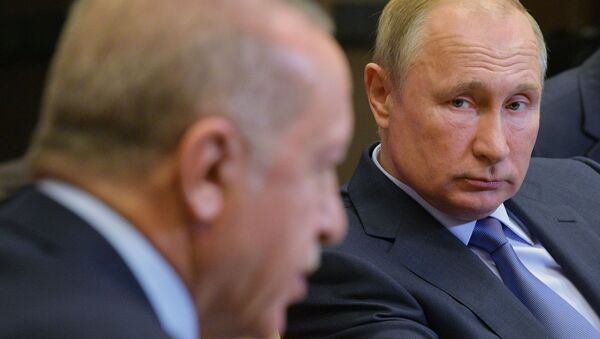“We were supposed to be there for 30 days; that was almost 10 years ago ... let’s get out,” US President Donald Trump said in Wednesday remarks at the White House. “Let someone else fight over this long-bloodstained sand.”
Ignoring the question of just how “sandy” Syria is, the fighting at least seems to have been averted for the moment: on Tuesday, the Turkish Defense Ministry called off a resumption of its Operation Peace Spring offensive in the eastern, Kurdish-controlled areas of Syria, launched earlier this month and then paused during a five-day ceasefire.
Instead, Turkish President Recep Tayyip Erdogan and Russian President Vladimir Putin negotiated an arrangement to keep the peace that makes few people happy, Sputnik reported. The agreement cedes Turkish control of some areas and recognizes the principle of a Kurd-free “Safe Zone” 10 kilometers deep along the Syrian-Turkish border, enforced by joint Russian-Turkish patrols.
Rick Sterling, an investigative journalist and member of the Syria Solidarity Movement, told Radio Sputnik’s Loud and Clear Wednesday that the 10-point agreement reached at Sochi was “a win-win for the idea of peace in Syria.”
Chaos on the Wane
“The predicted chaos and carnage is not happening, and I think the neocons in the US and those who insist on the US empire maintaining a foothold and driving a wedge in various parts are really upset,” Sterling said, dissenting from mainstream publications like the New York Times, which have predicted an amplification of violence. “So, Trump is going his own here, in the face of fierce opposition in the media and in the deep state.”
The arrangement revives the 1998 Adana Agreement, a pact between Ankara and Damascus that laid out how the two states would cooperate to end incidents involving Kurds in Syria crossing the border to help Kurds in Turkey - precisely what Erdogan claimed Operation Peace Spring was about. However, there was little evidence that such aid was flowing to the Kurdish Workers Party (PKK), a Kurdish political party labeled a terrorist organization by Ankara and banned in Turkey.
“The PKK actually had a peace agreement; there was no violence for several years,” Sterling pointed out, noting that “that exploded because of Erdogan, in 2015,” and that the left-wing People’s Democratic Party in Turkey “were not seeking a separate state and they were renouncing violence, and they were working, they became the third-largest political party in Turkey. It was Erdogan [who] was responsible for the ending of the peace agreement and the explosion of violence in the south” of Turkey.
However, Sterling pointed out that in recent years, the shoe has been very much on the other foot.
“Turkey has facilitated the terrorists flooding into Syria,” he told hosts Brian Becker and John Kiriakou. “Erdogan has been a major factor in the war in Syria. Most of the terrorists who entered Syria went through Turkey, but that situation now is coming to an end.”
‘A Kurdish Protectorate’
Sterling said he agreed with the Times, which characterized the US occupation of eastern Syria as a “Kurdish protectorate.”
“That sums it up in a nutshell: the US was using the Kurds to divide Syria, to separate Syria. It puts it explicitly: an American protectorate,” Sterling said, noting the Times let the mask slip further by drawing parallels to US bases in other regions of the world, such as Japan. “Basically, the US was hoping to establish a permanent presence” in eastern Syria, Sterling said, “and that is what Trump is making first steps at changing.”
A map of #Syria #oil & gas fields. Before the war, Syria made 387K barrels/day & sold 140K, accounting for 25.1% of state income. US/Kurdish areas in east (Omar, al-Shadadi, Suwayda fields) could today make at least 60K bpd.
— Morgan Art-boo-khina 👻👻 (@LavenderNRed) October 23, 2019
US "securing the oil" is abt denying Syria recovery $. pic.twitter.com/g1qWcEqghq
However, Trump won’t be totally pulling US troops out of the territory: “We’ve secured the oil, and, therefore, a small number of US troops will remain in the area where they have the oil. And we’re going to be protecting it, and we’ll be deciding what we’re going to do with it in the future,” he said Wednesday. Defense Secretary Mark Esper noted the day prior that no troop number had yet been arrived at.
Syria’s oil fields are not vast, but before the civil war broke out in 2011, they accounted for a substantial part of government revenue. In 2010, oil sales accounted for one-quarter of state income, or $3.2 billion, according to International Monetary Fund data, but only 0.5% of global output.
According to OilPrice.com, in 2011, Syria produced 387,000 barrels of crude oil daily and exported roughly one-third of that, most of it coming from the easternmost Deir ez-Zor and al-Hasakah governorates - the areas seized by Daesh in 2014 and then liberated by the Kurdish Syrian Democratic Forces, supported by the US. The Washington Post noted earlier this week that the areas still controlled by Kurdish forces contain enough oil wells to produce a theoretical 60,000 barrels of oil per day.

